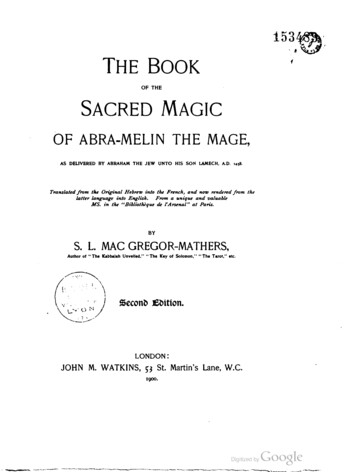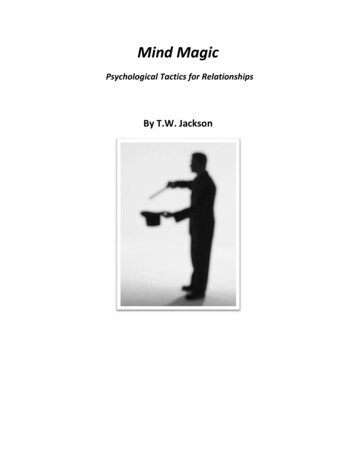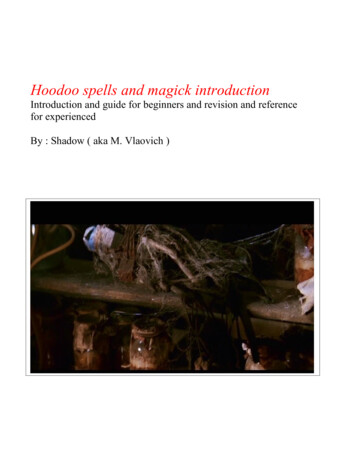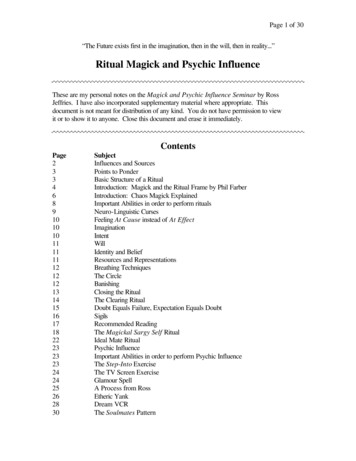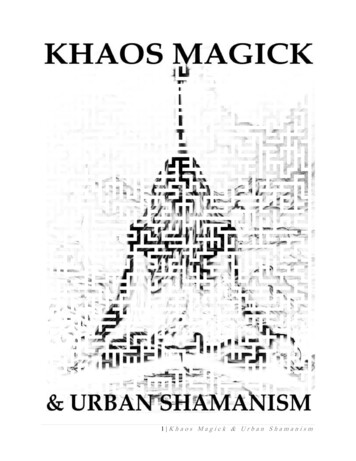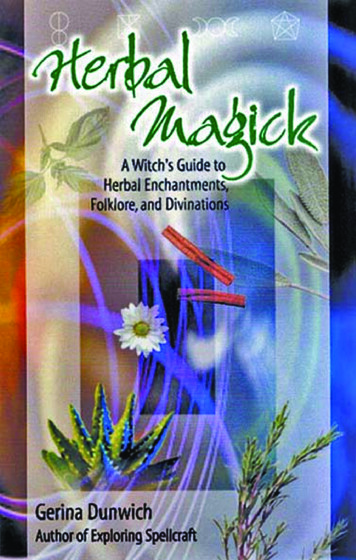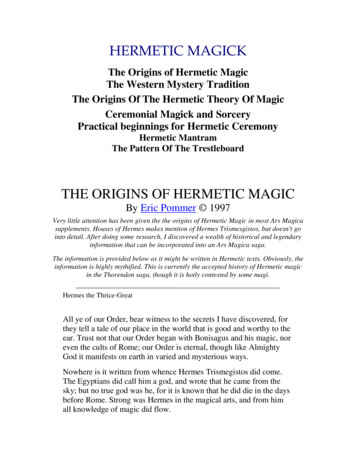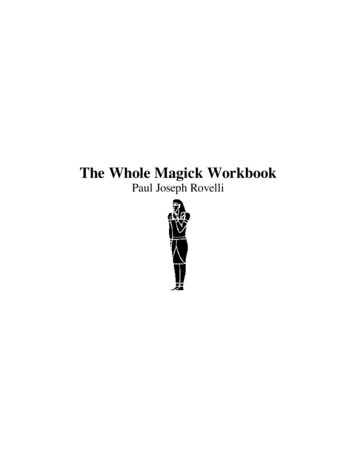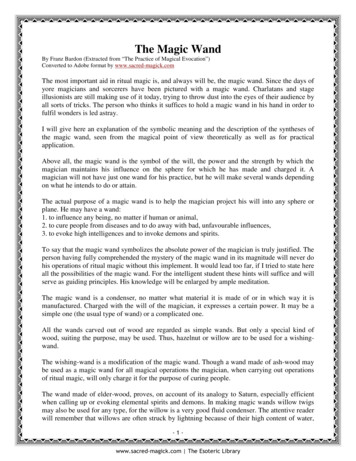
Transcription
The Magic WandBy Franz Bardon (Extracted from “The Practice of Magical Evocation”)Converted to Adobe format by www.sacred-magick.comThe most important aid in ritual magic is, and always will be, the magic wand. Since the days ofyore magicians and sorcerers have been pictured with a magic wand. Charlatans and stageillusionists are still making use of it today, trying to throw dust into the eyes of their audience byall sorts of tricks. The person who thinks it suffices to hold a magic wand in his hand in order tofulfil wonders is led astray.I will give here an explanation of the symbolic meaning and the description of the syntheses ofthe magic wand, seen from the magical point of view theoretically as well as for practicalapplication.Above all, the magic wand is the symbol of the will, the power and the strength by which themagician maintains his influence on the sphere for which he has made and charged it. Amagician will not have just one wand for his practice, but he will make several wands dependingon what he intends to do or attain.The actual purpose of a magic wand is to help the magician project his will into any sphere orplane. He may have a wand:1. to influence any being, no matter if human or animal,2. to cure people from diseases and to do away with bad, unfavourable influences,3. to evoke high intelligences and to invoke demons and spirits.To say that the magic wand symbolizes the absolute power of the magician is truly justified. Theperson having fully comprehended the mystery of the magic wand in its magnitude will never dohis operations of ritual magic without this implement. It would lead too far, if I tried to state hereall the possibilities of the magic wand. For the intelligent student these hints will suffice and willserve as guiding principles. His knowledge will be enlarged by ample meditation.The magic wand is a condenser, no matter what material it is made of or in which way it ismanufactured. Charged with the will of the magician, it expresses a certain power. It may be asimple one (the usual type of wand) or a complicated one.All the wands carved out of wood are regarded as simple wands. But only a special kind ofwood, suiting the purpose, may be used. Thus, hazelnut or willow are to be used for a wishingwand.The wishing-wand is a modification of the magic wand. Though a wand made of ash-wood maybe used as a magic wand for all magical operations the magician, when carrying out operationsof ritual magic, will only charge it for the purpose of curing people.The wand made of elder-wood, proves, on account of its analogy to Saturn, especially efficientwhen calling up or evoking elemental spirits and demons. In making magic wands willow twigsmay also be used for any type, for the willow is a very good fluid condenser. The attentive readerwill remember that willows are often struck by lightning because of their high content of water,
and their capability of absorbing. He may also remember the old saying referring tothunderstorms: "From the willow flee, look for a beech-tree".The wood of an oak or an acacia, too, is an excellent material for making a magic wand. It is,indeed, very easy to make a magic wand of any of the kinds of wood mentioned.Cut a twig, approximately 3/8 to 3/4 ins. in diameter and about 12-20 ins. in length, remove itsskin and smooth it.Often the cutting of a magic wand has been restricted to special astrological periods, and themagician acquainted with astrology is free to make use of his knowledge when making a wand.But such a procedure is by no means necessary, since the magician knows very well that the starsmay have a certain influence, but that they cannot force the wise to do anything, as he actuallyrules them. Thus anybody may, if he likes, make by himself a magic wand out of one of thematerials mentioned above.If the magic wand is to serve ritual purposes, you are recommended to use a new knife whencutting the twig. The knife may later be used for other ritual purposes or other magicaloperations. It should, in that case, never be employed for any common purpose.If the magician does not expect to use the knife again after having cut and smoothed the twig forthe magic wand, he should bury it in order to prevent it from ever coming into the hands ofanyone else.Another kind of magic wand is the steel magnet which has to be equipped with an insulated grip.Take a round steel rod (the best steel to use is electro-steel, (i. e. magnet steel) approximately 1220 ins. long with a diameter of 3/8 ins., polish it and have it nickel-plated to prevent it fromrusting. After having nickelplated the rod, the magician may magnetize it by means of an electriccoil, similar to the magnetization of a horse-shoe or the magnet of an electrical motor. Thegreater the power of attraction of the magnet, the better it works. This is the way to get a verystrong steel magnet which will not only do its work as such, but which will also serve as anexcellent magic wand for many magical and magnetic experiments.First of all one must locate the north and the south pole on the magic electro magnetic rod andmark both poles: the south-pole with a minus and the north-pole with a plus. For the insulation ofthe rod the middle must be then wound with a silk ribbon as wide as the palm, i. e. about 3-4 ins.A rubber hose of the same length or a wooden handle that has been pierced for this purpose mayalso be used.Such a wand will enable the magician to cause many magnetic and magical phenomena, ofwhich only a few will be treated here. If the magician is working with the electromagnetic fluidof the universe, intending to intensify it strongly in the physical world, then he must take hold ofthe wand in such a manner that his right hand will touch the plus-pole and his left hand theminuspole, with the ends of the rod touching the middle of his palms. After this the electricalfluid from the universe has to be led via the right side of the rod into the magician's body bymeans of the imagination. The plus-radiation of the rod (odpole-radiation) will thus be stronglyintensified as it has the same oscillation and will make it easier for the magician to store theelectrical fluid in his body.
The same procedure has to be applied to the magnetic fluid of the south-pole. Vice versa themagician now intensifies the electrical fluid again, which he has previously stored up in hisbody, this time concentrating it into the plus-end of the rod so strongly that he can make hisinfluence work directly on the physical world.The same goes for the magnetic fluid which he will be able to store up in his left, that is thenegative pole radiation. The middle of the rod, covered with the insulating material, will remainneutral. If the magician, by force of imagination, now concentrates his intention into thecondensed electromagnetic fluid of the steel magnet the wand indeed becomes a magic wand. Bymeans of the electromagnetic fluid, which radiates as a brilliant light from the rod, anyrealization on the physical world will be possible. Initiates usually apply this wand forinfluencing sick people and for all magnetic phenomena.This magic electromagnetic wand is, by the Law of the Universe, an excellent condenser with thesame kind of oscillation as the universe, but in a most subtle way. The person meditating on thiswill be able to find other methods easily due to the universal laws. The magician will, forinstance, be able to either pull the fluid out of the universe like an antenna and store it in hisbody, or to transfer it by force of imagination to other people, near him or far away. The wandwill soon be an indispensible implement for the magician, for the positive and negative powersconcentrated in it will help him to create the necessary oscillation in his electromagnetic fluid.Besides this, there are magic wands charged either with solid liquid, or combined condensers.Much could be said about how to make such rods and which methods are to be used, but I willonly mention the most appropriate to serve the magician in his work. Take the twig of an elderbush, 12-20 ins. long and 3/8 to 3/4 ins. in diameter, peel off its skin and smooth it with sandpaper. Then remove its pith so that you get an elder-pipe. Put a cork on the one end of the pipeand seal it with sealing-wax, insert a condenser (a liquid condenser, if you like) from the otherside, then also seal this end of the pipe airproof. The rod is now ready for use.You may, if you wish, use a different kind of wood, for instance, the twig of an ash, willow oroak tree, or of a hazelnut bush. The twig, which has no pith must, however, be pierced throughcarefully with a fine drill, making a pipe of it. Instead of the liquid condenser a solid condensermay be used, the same kind of condenser described in "Initiation into Hermetics".It is also possible to use a piece of blotting paper soaked with a liquid condenser instead of asolid condenser, which, after it has dried well, is charged, and then, after having been rolledtogether, is inserted into the hollow space of the rod.The disadvantage of wood is that it will, as time goes by, moulder or be affected by the fluidcondenser, which will cause it to become perforated. It might therefore as well be replaced by ametal-pipe. Those kinds of metals which are good conductors of heat and electricity are best. Thebest of all, of course, is a copper pipe with a diameter of 3/8 to 1/2 inch.In order to avoid any oxidization on the surface of the metal, the pipe can be nickel, chrome, ortin-plated before it is filled with the condenser. One opening must be soldered together at once,the other immediately after having filled up the pipe; thus you get a first class magic wand,applicable for all purposes.
Magicians working with the magnetic and the electric fluid in turn will do well to procure forthemselves a rod made out of a thin iron or steel pipe, as recommended above, for operationswith the magnetic fluid, and a copper-pipe for operations with the electric fluid. A universalwand is manufactured in the same manner, with the exception that a nickel-plated brass pipemust be used, instead of a pipe of copper or iron.The magician wealthy enough for financial considerations not to matter can use, instead of thefluid condenser, a condenser made of semi-precious stones. He will use for his electric fluid, acopper-rod the inside of which is filled with pulverized amber, an unsurpassed condenser for thiskind of fluid.For his operations with the magnetic fluid he will, in this case, have to fill up the steel-pipe withpulverized rock-crystal instead of using a solid condenser. Rock-crystal, again, is a very goodfluid condenser for the magnetic fluid. But it is also possible to solder two separate small pipes,thus making a single rod out of them; one half of the tube is, in this case, filled up withpulverized amber, the other with pulverized rock-crystal. Having done this, a single rod,separated in the middle, will contain both kinds of fluid condensers. In a case like this, however,the two halves must be connected by a thin piece of copper - or iron - wire going through thecentre of both pipes. The outside of such a rod may be nickel- 45 plated. This ideal wand thenhas a unique fluid capacity and will serve any magical operation.There is still another possibility: a wooden rod may by ornamented with seven rings made of theplanetary metals. The rings should be fixed to the rod in quabbalistic order. That is, a golden ring(for the Sun) is placed in the middle of the rod and three metal rings on each side.The following metals may be used for the rings in question:Lead corresponding to SaturnTin corresponding to JupiterIron corresponding to MarsGold corresponding to the SunCopper corresponding to VenusBrass corresponding to MercurySilver corresponding to the MoonApart from this, the rings may have engravings portraying the intelligences of the abovementioned planets. The use of a wand like this will, in general, be restricted to the conjuration ofintelligences of the seven planets. When used for other purposes, it will not prove superior to theother types of wands. This is all the magician needs to know: from the examples above he will,by himself, be able to proceed to other variations.The shape and the size of the wand plays a minor part. The most important thing about a magicwand is its charging for practical use, a description of which is given below.The charge of a magic wand is done in much the same way as the charge of a magic mirrorprovided with a fluid condenser for special purposes. There are many ways of charge for a wand.They all depend on what the magician intends or wants to use it for.
Above all, the magician must always be aware of the fact that the magic wand is a symbol ofhis will, his strength and his power, and that it is representing a container like a fluid condenserof that power, quality etc. in which he is not only able to transfer, but also to store up that power,according to his wish, to an exeedingly high density.It matters little if such a rod is nothing but a simple twig, cut and adapted accordingly, or if it is acomplicated wand, saturated or filled up with a fluid condenser.A magic wand may be charged with:1. the magician's will-power2. special qualities, faculties, etc.3. magnetism, biomagnetism, etc.4. the elements5. Akasha6. the help of a light-fluidHere are some examples for practical use:With regards to Point 1, charge with will-power:Take into your hand the wand which you have prepared and concentrate your will on, or ratherinto, the wand; that is, transfer your whole consciousness into the wand so that you feel you arethe wand itself.Your concentration must then be filled with the idea that all your will-power, your strength, isembodied in the wand. This kind of concentration must last for at least five minutes without anyinterruption. Already at the moment of embodying your will into the wand you have to think thatwhenever you take the
By Franz Bardon (Extracted from “The Practice of Magical Evocation”) Converted to Adobe format by www.sacred-magick.com The most important aid in ritual magic is, and always will be, the magic wand. Since the days of yore magicians and sorcerers have been pictured with a magic wand. Charlatans and stage illusionists are still making use of it today, trying to throw dust into the eyes of .


